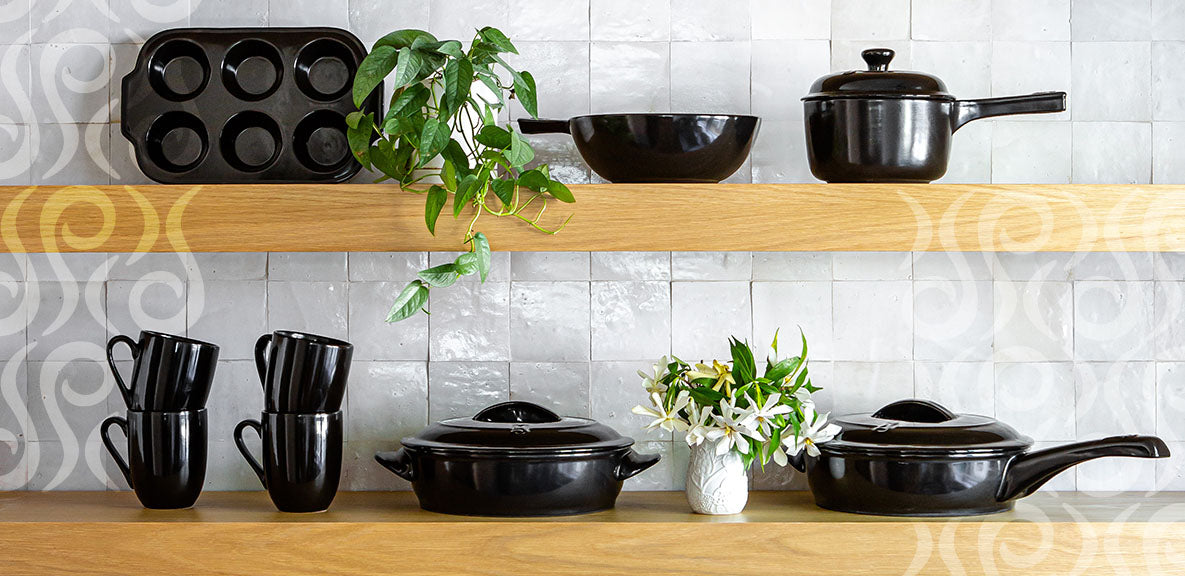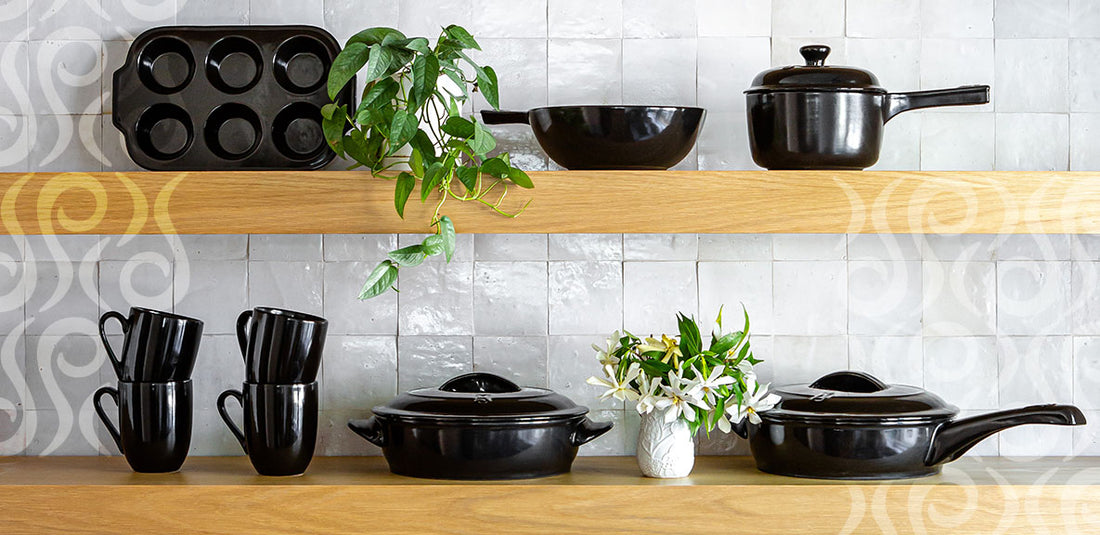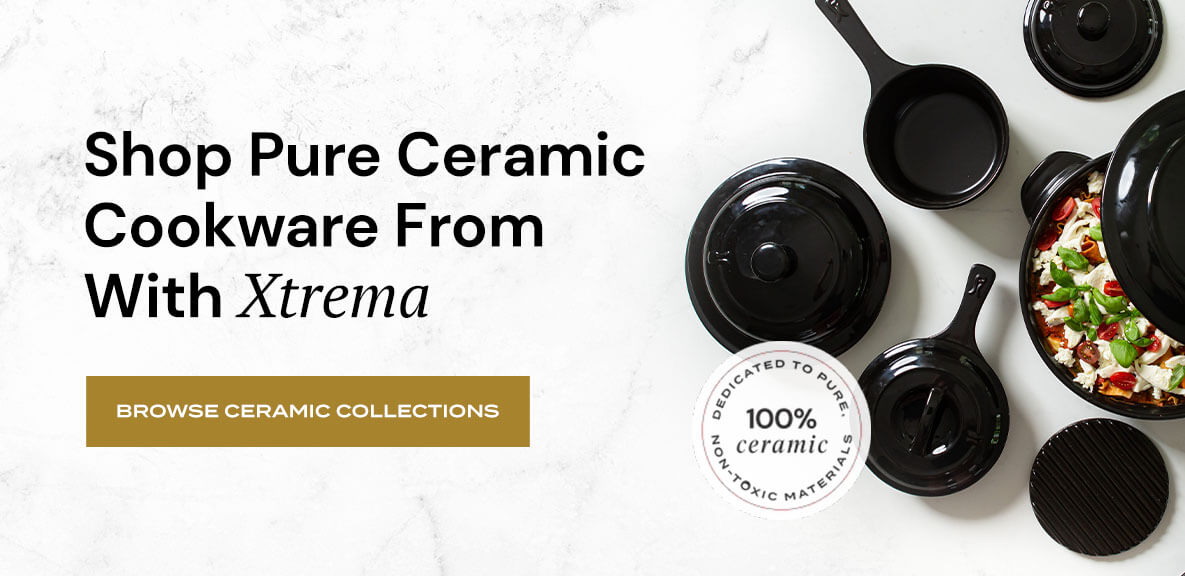
The right pots and pans are essential if you are passionate about cooking. Different types of pots and pans impact the dishes you can cook and play a part in technique and personal preference, too. Your collection of pots and pans can also affect your kitchen efficiency, and of course, choosing suitable pots and pans is also vital if you are new to cooking and want to sharpen your skills.
No matter where you are in your cooking journey, this buying guide to cookware can help you understand your choices. We're providing a comprehensive list of pots and pans and some factors to consider when purchasing your new kitchen supplies.
What Are the Different Types of Pots?
You may surprised at how many different types of pots you can find on the market! Though each pot is designed for a unique purpose, their uses often overlap. Because of this, your standard kitchen could make do with a handful of these pots.
Dutch Ovens
Dutch ovens are among the most versatile pots. They are broad, deep and sturdy, with thick sides and a tight-fitting lid. Dutch ovens are fitted with handles on both sides to make them easy to move around. Dutch ovens, especially ceramic Dutch ovens, are exceptional at evenly distributing heat, and you can use them on the stovetop or in the oven. They also come in large sizes, making them great for meal prepping or cooking for a large group of people. You can cook these delicious dishes with your Dutch oven:

- Casseroles
- Stews
- Roasts
- French fries
- Breads
- Baked desserts
Stockpots
Stockpots are big pots that can hold a large capacity of liquid. They have a somewhat cylindrical shape with a broad, round base and are usually made from stainless steel. Stockpots are ideal for cooking dishes in large quantities, such as prepping soups for the week or cooking for a party. They have handles on the sides, making these heavy pots easier to carry. With its thick base, the stockpot helps you slowly simmer foods and prepare stews, stock and soups.
Slow Cookers and Crock Pots
Slow cookers, or crock pots, are electric pots that cook meals at a lower temperature for a longer time. They typically have a range of heat settings from low to high and are excellent for stewing and cooking meats that need to be tender, like brisket.
Braisers
Braisers are also called roundeau pans. They are shallower than stockpots but have wide, heavy bases. You would usually use a braiser for meals that need to be simmered over a long period of time and for braising vegetables and meat. If you want to cook a meal where natural juices add to the flavor or your meal calls for soft and tender foods, then braisers are a good bet.
Pasta Pots
A pasta pot's main feature is a fitted strainer that makes draining pasta and other foods more convenient and efficient. You cook the pasta in the trainer basket and simply lift the basket so that the hot water drains to the second pot. Contrary to the name, you aren't limited to cooking pasta in pasta pots. You can also use this pot for cooking certain seafood and vegetables.
Double Boilers
A double boiler has a unique design featuring an inner and outer pot or container. You typically use a double boiler for temperature-sensitive recipes like making custards, melting chocolate or preparing sauces. Double boilers are one of the best choices if you need steam to prepare your dish. You simply fill the pot with water, add the ingredients you need to prepare to the inset pot and place the inset pot over the pot with the water that will boil. You can then leave the inset pot uncovered — especially if you need to stir often — or cover the inset pot with a lid.
Fryer Pots
Chefs sometimes use fryer pots as a more affordable alternative to fryers. Fryer pots are also suitable for making small batches of fried foods like samosas, mozzarella sticks, chicken fingers or french fries. The main feature is the draining basket you put food directly into before placing it in the main pot filled with oil. Frying pots have wide bottoms to help them heat up quickly and evenly.
What Are the Different Types of Pans?
Like pots, there is a diverse range of pans, each suited to preparing specific meals.
Saucepans
Because of the saucepan's design — high sides, a deep base and only one long handle— there is debate over whether saucepans are true pans or pots! In reality, a saucepan can be used as both a pan and a pot, but it is best used as a pan for reducing sauces. With your saucepan, you can:

- Reduce sauces.
- Deep-fry small batches.
- Braise small batches.
- Simmer foods.
- Make soups.
Frying Pans and Skillets
Frying pans are kitchen essentials. You would typically use a frying pan for frying, sauteeing, deglazing, searing and even poaching — making it a highly versatile kitchen staple. Frying pans have long handles and curved sides so that you can quickly stir food and slide it out of the pan when cooked. The sloped sides also help prevent steam from forming so food can fry properly and quickly. Frying pans are ideal for making stir-fried meals, eggs, chicken, ground beef and more.
Saute Pans
Saute pans have wide bases and straight sides. They're designed to provide an optimal cooking surface and have the capacity to hold more liquid. You can use saute pans for a range of recipes, including those that call for sauteeing, braising, stir-frying, poaching and deglazing. Though saute pans are not as deep as other cookware, they are deeper than frying pans, which sets the two apart.
Roasting Pans
Roasting pans are made for the oven. They are sizeable, rectangular dishes with flat bottoms and shallow sides, and they are usually made from aluminum or steel. With a roasting pan, you can cook foods until they're tender or crispy and enjoy flavorful meals like meat, vegetables and potatoes.
Woks
Anyone who enjoys making Asian or Asian-inspired dishes knows the value of a good wok! Woks are deep pans with high sides that taper down to the base. This means heat is distributed well, and you can cook food quickly and evenly. The high walls of the pan also mean you can toss foods more easily while you cook. They're perfect for stir-frying, making egg fried rice and preparing ramen.
Paella Pans
Paella pans are shallow pans with small, sloping sides and wide, flat bases. These pans are ideal for meals that require frequent and easy stirring and for dishes that need quick but even cooking. You can use a paella pan for toasting foods like rice or nuts or for searing steaks, chicken or fish fillets. They also work as a griddle for eggs, pancakes and bacon. They're even great for stir-frying. Paella pans are usually compatible with all heat sources and are typically made from aluminum or cast-iron steel.
What to Consider When Buying Cookware
With the various pots and pans out there, you'll want to consider which items will fit your kitchen best before purchasing. Consider these factors as you browse for the best pots and pans.
Personal Cooking Style and Needs
If you cook daily — whether for yourself or your family — the most crucial consideration is which dishes will make your meal times easier. For example, pots like Dutch ovens, frying pans and stockpots are effective for making a variety of one-pot meals in large quantities. This serves the double purpose of saving time while you cook and lessening the number of dishes you have to wash after your meal!
Perhaps you are more serious about sharpening your culinary skills. If this is the case, you may consider getting pots and pans that allow you to make a range of more diverse and unique meals. You could get a double boiler for preparing delicate sauces like traditional hollandaise, as well as desserts that call for tempering your eggs, like creme brulee. Remember: Your pots and pans are an investment and items that you will use often for years to come. You want the dishes to serve you well, so reflecting on what will suit your needs and make your life more convenient is a top priority.
Cookware Materials
Before purchasing pots and pans, consider the materials they are made out of, as materials affect various aspects of cooking:
- Some materials heat quickly and others more slowly, affecting cooking time.
- Different materials distribute and retain heat at varying levels, which affects how thoroughly and evenly your food is cooked.
- Certain foods — like acidic dishes — will react with metal cookware.
- Some materials, like metals, can also leach into food. For this reason, it is best not to purchase low-quality metal pots and pans.
- Some materials aren't non-stick, making cleaning and maintaining your dishes tricky.
- Certain materials need to be coated so that they do not rust or react with foods. Keep in mind that coating does not always last and requires careful maintenance.
Think about the pros and cons of different materials and how they might affect your day-to-day cooking and cleaning. There are five main types of materials pots and pans are made from:

- Ceramic: Ceramic is one of the best cookware materials. Pure ceramic cookware is durable, non-toxic and non-reactive. Ceramic dishes are easy to clean, and when you look after them properly, they can last for generations. Plus, your ceramic pots and pans won't hold other flavors or odors from previous dishes if you clean them correctly. Ceramic cookware also heats evenly, making it ideal for preparing an assortment of your favorite dishes.
- Aluminum: Aluminum pans are lightweight, durable and easy to clean. Aluminum on its own heats up quickly, but because this metal is reactive, aluminum pans are always coated so that they are safe to cook with. The coating does pose some downsides — it can scratch off easily, and cheaper coatings aren't always safe.
- Copper: Copper cookware is durable, but it is also heavy and generally costs more. Though copper heats quickly and distributes heat well, it is similar to aluminum in that it is reactive and, therefore, must be lined with other materials, such as stainless steel.
- Stainless steel: Stainless steel is a popular material for pots and pans. Stainless steel heats well so that you can cook food thoroughly and quickly. It is also easy to clean when you use the right products. However, some stainless steel cookware may leach heavy metals into food.
- Bare and enameled cast iron: Cast iron, like other metals, keeps heat well and distributes it evenly. One of the top benefits of using cast iron is that you can use it for outdoor cooking on open fires since cast iron withstands high temperatures very well. Cast iron does require careful care and maintenance — you must clean them properly and season your cast-iron pots and pans to prevent rusting. You can also find cast-iron cookware coated with enamel, which stops the iron from altering flavor and makes it easier to clean. Always be careful with coated products, though, as they can chip and peel off.
Cleaning and Maintainance
Caring for your cookware is a vital consideration. If possible, invest in high-quality cookware that is durable and easy to clean. Ceramic cookware is durable and does not require high maintenance. You can clean pure ceramic cookware with water and a damp cloth. You can also use gentle, natural cleaners like white vinegar to keep your cookware free from odors and stains. Always check cookware to see whether it is dishwasher safe.
Budget
Naturally, you need to consider your budget. While there are some affordable options, they might come with some disadvantages. For example, aluminum and cast-iron cookware are more affordable options, but you'll want to consider how long they'll actually last and how much maintenance they'll require. So, that said, it is worth investing in high-quality cookware that can last for generations. When you own quality cookware, the benefits pay off in the long term. Your cookware will last as long as you need it, and you can pass the cookware on to your kids or other family members, too.
Shop Pure Ceramic Cookware From Xtrema
Having a variety of pots and pans in your kitchen positively impacts the range of meals you can make and the cooking techniques you can learn. Purchasing premium cookware is a lifelong investment that can add more joy and convenience to your meal times. You can choose to purchase a set or buy different pots and pans individually through the years as you build up your collection.
At Xtrema, we are committed to providing you with the highest quality pure ceramic cookware and bakeware to add to your kitchen. Xtrema products are non-toxic, versatile, aesthetic and long-lasting. When you purchase from our range of pure ceramic cookware, you prioritize your health, well-being and joy in the kitchen.
Shop our range of pure ceramic cookware and bakeware items today!

